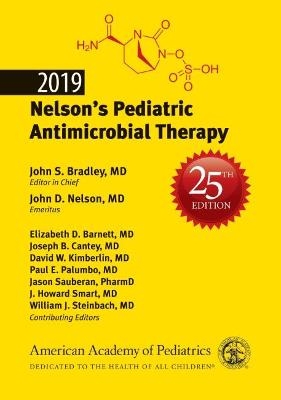
2019 Nelson's Pediatric Antimicrobial Therapy
American Academy of Pediatrics (Verlag)
978-1-61002-210-1 (ISBN)
- Titel erscheint in neuer Auflage
- Artikel merken
This best-selling and widely used resource on pediatric antimicrobial therapy provides instant access to reliable, up-to-the-minute recommendations for treatment of all infectious diseases in children.
For each disease, the authors provide a commentary to help health care providers select the best of all antimicrobial choices. Drug descriptions cover all antimicrobial agents available today and include complete information about dosing regimens. In response to growing concerns about overuse of antibiotics, the program includes guidelines on when not to prescribe antibiotics.
Key Features:
Practical, evidence-based recommendations from the experts in antimicrobial therapy
At-a-glance tables of bacterial and fungal pathogen susceptibilities to commonly used antimicrobials
Information on antimicrobial stewardship where relevant throughout the book
Updated references and reviews for therapy for clinically important infections (e.g., community-acquired pneumonia in children, endocarditis, MRSA infections)
Antibiotic therapy for children with obesity
Antimicrobial prophylaxis/prevention of symptomatic infection
Maximal adult dosages and higher dosages of some antimicrobials commonly used in children
John S. Bradley, MD has been the Director of the Division of Infectious Diseases at Rady Children's Hospital-San Diego since 1988, and is currently Professor and Chief, Division of Infectious Diseases, Department of Pediatrics, University of California, San Diego School of Medicine. He has served on the American Academy of Pediatrics Committee on Infectious Diseases (Red Book Committee) 2004-2010, and the Council of the Pediatric Infectious Diseases Society (PIDS) Council, 2007-2011 where he promoted the development of a PIDS Antimicrobial Stewardship program. John D. Nelson, MD Emeritus is Professor Emeritus of Pediatrics at the University of Texas Southwestern Medical Center and Children's Medical Center, the same institution since he started his career back in 1957. At UT Southwestern he established the first formal Pediatric Infectious Disease fellowship program with Dr. Kenneth Haltalin and later Dr. George McCracken. He also went on to establish the National Pediatric Infectious Disease Seminar with Dr. McCracken and in 1982 they founded the Pediatric Infectious Disease Journal for which they continue as Chief Editors. In 1975 Dr. Nelson produced the first edition of the Pocket Book of Pediatric Antimicrobial Therapy which has gone through 20 biennial editions and is now edited by Dr. John Bradley. David W. Kimberlin, MD, FAAP is the Principal Investigator for the Collaborative Antiviral Study Group (CASG), an international network of pediatric academic medical centers that evaluates antiviral therapeutics in rare diseases with a large unmet medical need, including neonatal herpes simplex virus (HSV) infections, congenital cytomegalovirus (CMV) disease, congenital Zika infection, neonatal and infantile influenza infection, and neonatal enteroviral sepsis syndrome. Studies conducted by the CASG have led to new drug indications and label changes for acyclovir, valganciclovir, and oseltamivir, and non-CASG studies conducted by Dr. Kimberlin also have led to label changes for valacyclovir. Dr. Kimberlin is Editor of the 2018 AAP Report of the Committee on Infectious Diseases (Red Book). He also was Editor of the 2015 edition, and was an Associate Editor of the 2012 and 2009 editions. Dr. Kimberlin is a Past-President of the Pediatric Infectious Diseases Society (PIDS), which is the world's largest organization of professionals dedicated to the treatment, control, and eradication of infectious diseases affecting children. He also serves as Vice Chair for Clinical and Translational Research in the UAB Department of Pediatrics, where he holds the Sergio Stagno Endowed Chair in Pediatric Infectious Diseases and is Co-Director of the Division of Pediatric Infectious Diseases.
Introduction
1. Choosing Among Antibiotics Within a Class: Beta-lactams, Macrolides, Aminoglycosides and Fluoroquinolones
2. Choosing Among Antifungal Agents: Polyenes, Azoles, and Echinocandins
3. How Antibiotic Dosages Are Determined Using Susceptibility Data, Pharmacodynamics and Treatment Outcomes
4. Approach to Antibiotic Therapy of Drug-Resistant Gram-negative Bacilli and Methicillin-Resistant Staphylococcus aureus
5. Antimicrobial Therapy for Newborns
6. Antimicrobial Therapy According to Clinical Syndromes
7. Preferred Therapy for Specific Bacterial and Mycobacterial Pathogens
8. Preferred Therapy for Specific Fungal Pathogens
9. Preferred Therapy for Specific Viral Pathogens
10. Preferred Therapy for Specific Parasitic Pathogens
11. Alphabetic Listing of Antimicrobials
12. Antibiotic Therapy for Children Who Are Obese
13. Sequential Parenteral-Oral Antibiotic Therapy (Oral Step-down Therapy) for Serious Infections
14. Antimicrobial Prophylaxis/Prevention of Symptomatic Infection
Appendix: Nomogram for Determining Body Surface Area
References
Index
| Erscheinungsdatum | 14.01.2019 |
|---|---|
| Verlagsort | Elk Grove Village |
| Sprache | englisch |
| Maße | 114 x 165 mm |
| Themenwelt | Medizin / Pharmazie ► Medizinische Fachgebiete ► Pädiatrie |
| Medizin / Pharmazie ► Medizinische Fachgebiete ► Pharmakologie / Pharmakotherapie | |
| Studium ► Querschnittsbereiche ► Infektiologie / Immunologie | |
| ISBN-10 | 1-61002-210-6 / 1610022106 |
| ISBN-13 | 978-1-61002-210-1 / 9781610022101 |
| Zustand | Neuware |
| Haben Sie eine Frage zum Produkt? |
aus dem Bereich


